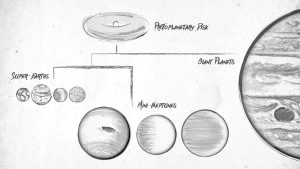Two ʻSpeciesʻ of Exoplanets Discovered Using Keck Observatory

New Branch in Exoplanet Family Tree: Artist sketch of a family tree of exoplanets. Researchers using data from the W.M. Keck Observatory and NASA’s Kepler mission discovered that these smaller planets can be cleanly divided into two size groups: the rocky Earth-like planets and super-Earths, and the gaseous mini-Neptunes. Photo credit: NASA/KEPLER/CALTECH (T. PYLE).
Scientists have discovered two distinct “species” of exoplanets using data gathered from W.M. Keck Observatory on Maunakea and NASAʻs Kepler mission.
In the new Caltech-led study, researchers identified rocky, Earth-like planets and larger, mini-Neptunes orbiting distant stars.
“Astronomers like to put things in buckets,” said Benjamin J. Fulton, the lead author in the study. “In this case, we have found two very distinct buckets for the majority of the Kepler planets.”
Kepler planets are those identified during the Kepler mission, which has been seeking out Earth-like planets since 2009. Scientists have found and confirmed more than 2,300 exoplanets through the NASA-led project.
In total, astronomers have confirmed nearly 3,500 exoplanets since they were first discovered in the mid-1990s. The findings in this latest study reveal a new dimension in the variety and types of planets that are orbiting stars similar to our own.
“This is a major new division in the family tree of planets, analogous to discovering that mammals and lizards are distinct branches on the tree of life,” says Andrew Howard, professor of astronomy at Caltech and a principal investigator in the study.
The studyʻs findings, to be published in The Astronomical Journal, indicate that our own galaxy tends to have either rocky planets that are up to 1.75 times the size of Earth, or mini-Neptune worlds shrouded in gas that range from 2 to 3.5 times the size of Earth. The data shows that our Milky Way galaxy rarely forms planets of any size between these two groups.
“In the solar system, there are no planets with sizes between Earth and Neptune,” says Erik Petigura, co-author of the study and a Hubble Postdoctoral Fellow at Caltech. “One of the great surprises from Kepler is that nearly every star has at least one planet larger than Earth but smaller than Neptune. We’d really like to know what these mysterious planets are like and why we don’t have them in our own solar system.”
The Caltech team, together with colleagues from several institutions, including UC Berkeley, the University of Hawai‘i, Harvard University, Princeton University, and the University of Montreal, used Keck Observatoryʻs High-Resolution Echelle Spectrometer (HIRES) to examine the size of Kepler planets.
They spent years gathering spectral data on stars hosting some 2,000 Kepler planets using HIRES. The instrument allowed them precise measurements of the sizes of the stars, and helped determine more accurate sizes of the planets that orbit them–four times more accurate than previous measurements.
“Before, sorting the planets by size was like trying to sort grains of sand with your naked eye,” said Fulton. “Getting the spectra from Keck Observatory is like going out and grabbing a magnifying glass. We could see details that we couldn’t before.”












